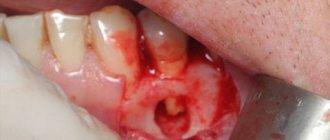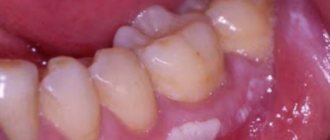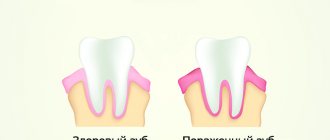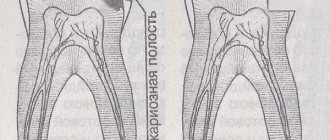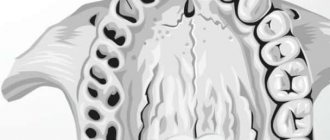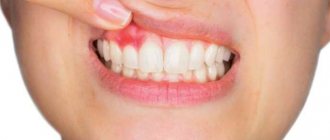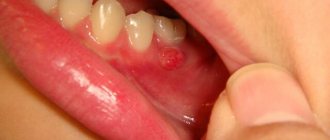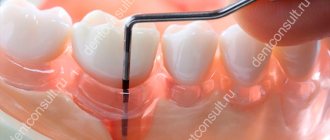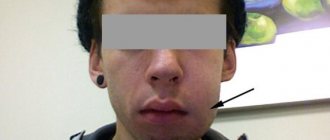Cervical caries is a separate form of pathology in which a carious cavity forms in the area of contact between the gum and tooth. The dentin in these places is especially thin, so if you do nothing, you can lead to the development of deep caries. You will learn about the symptoms and features of the course of the disease, methods of its prevention and treatment from this review. We draw your attention to the fact that the complexity of the pathology cannot be underestimated - if at first it is quite simple to cure, then over time the disease begins to be accompanied by severe complications.
Definition of disease
The tooth consists of an outer crown, a root and a neck. Darkening or a white spot of enamel in the gum area is an indication of cervical caries. At the stage of initial caries, the pathology is treated with drugs with a high fluoride content. Later it will be necessary to put fillings and carry out treatment. If the matter progresses to inflammation of the pulp, the treatment will be the longest and most difficult.
We also remind you that any carious position opens the door to infection, which is the cause of the formation of granulomas. Cervical lesions are considered one of the most dangerous because they cause destruction of the tooth at the base. Note that a lesion near the gums can cause the development of tooth root caries.
The enamel in the cervical area is very thin and deteriorates especially quickly.
Help from traditional medicine
Seeing a dentist is the only way to help yourself when a hole has formed in your gum; traditional medicine will tell you what to do to speed up healing after treatment. Natural ingredients will help tissues recover faster and avoid recurrence of the disease.
| What you need | How to cook | How to use |
| Calendula flowers, yarrow flowers and herb, dandelion root, sweet clover herb, tansy flowers, sorrel rhizome. | All herbs and flowers are taken in equal proportions. Everything is crushed using a meat grinder, ichthyol ointment with calendula oil is added to the mixture. Everything is thoroughly mixed. | This cream treats damaged areas of the gums. |
| Chamomile flowers. | For a tablespoon of herb you need to take two glasses of boiling water. The chamomile infusion should stand for two hours, after which it should be strained. | You need to take baths or rinse problem areas with infusion four times a day. |
| Three leaves of aloe and three leaves of Kalanchoe, a clove of garlic. | Grind all ingredients in a meat grinder and mix. | The finished pulp is wrapped in a bandage or gauze and applied to the sore gum three times during the day. It is not recommended to keep the medicine for longer than 10 minutes. |
We invite you to familiarize yourself with Flux Doesn't Hurt - ProfiMed - Aesthetic Dentistry
It is recommended to prepare all folk remedies immediately before use; it is advisable to use them within 12 hours of preparation. For each new day you need to prepare a new portion of folk medicine. Moreover, the price of most of the ingredients is not high and you can prepare them yourself.
Treatment of a fistula should begin at the first sign of a problem.
A fistula on the gum may appear suddenly, or it may begin to bother the patient some time before it appears. The location of the holes may vary depending on the location of the abscess.
Thus, a hole may appear in the gum between the teeth, or the fistula will be located relative to a specific tooth root. In all situations, treatment in the dentist’s office is indicated, and the sooner it is carried out, the sooner the damaged gums will recover.
Causes
Cervical caries develops for the same reasons as regular caries - poor oral hygiene, accumulation of soft plaque (a breeding ground for bacteria) and the formation of tartar. The cervical area collects plaque quickly, and removing food debris in these places is very difficult (soft tissues are injured). Food particles accumulate in subgingival pockets, where they begin to decompose and release lactic acid (substances that leach minerals from the enamel).
The main reasons for the development of cervical caries are poor personal hygiene and a love of sweet foods. Take this into account as part of disease prevention.
Also at risk are lovers of sweets and people whose diet lacks vitamins. Hormonal imbalance, taking certain medications, pregnancy are also difficult conditions for teeth, in which you should be especially vigilant. More information about the treatment of caries in pregnant women in this article.
Causes of the disease
Experts cannot identify any of the possible causes of the appearance of a wedge-shaped defect as determining.
There are several factors that can affect the mineral composition of the enamel in such a way that the disease arises and develops:
- Chronic exposure to an aggressive acidic environment, provoked by frequent consumption of certain foods and drinks. These are sweets, sparkling water, natural juices. In some cases, the formation of high acidity in the mouth is caused by a disease of the digestive system, in which the contents of the stomach enter there;
- Increased pressure on the tooth that occurs during hygiene procedures. Too hard a brush, frequent use of abrasive pastes contribute to the destruction of enamel;
- Incorrect load on teeth resulting from malocclusion. To one degree or another, this is typical for many people. An incorrect bite makes it impossible to chew food normally so that the pressure on the teeth is distributed evenly. As a result, a wedge-shaped defect appears on those of them who work harder than others;
- Common diseases that affect the structure of the enamel, weakening its mineral composition. These are hormonal disorders, digestive problems (with the intestines and gall bladder), nervous ailments;
- Oral diseases associated with changes in the composition of saliva and the amount produced. Under its every minute influence, the enamel also weakens, as it loses calcium;
- Neglect of oral hygiene. The result of this is the appearance of plaque on the root parts of the teeth. The deposits harden, affecting the mineral composition of the enamel for the worse.
Symptoms and clinical manifestations
Symptoms of cervical caries depend on the stage of the disease. At the initial stage, the defect develops only on the front teeth (in the so-called smile zone). At first a chalky small spot forms, but there is no particular discomfort. For this reason, a person does not suspect anything and does not take the necessary measures. Read more about why white spots appear on teeth here.
Stages of the disease
At the stage of medium caries, the spot becomes pigmented and acquires a brown or yellowish tint. Destructive processes begin in the enamel of the tooth neck, pain appears upon contact with hot, cold, and sour foods. The next stage is deep. The tooth begins to ache severely simply when there is a current of cold air or temperature changes. At this stage, the deep tissues of the tooth located near the endings of the nerve fibers are damaged. It may be painful to bite and brush your teeth.
In advanced stages of cervical caries, a carious hollow is formed into which food particles become clogged. Over time, this leads to fracture of the dental crown.
Treatment of wedge-shaped dental defects
The method of treating the disease depends on the stage of the process. But in any case, you should stop using too hard a toothbrush and stop drinking sugary carbonated drinks. It is also necessary to eliminate problems with malocclusion by consulting an orthodontist.
If left untreated, progressive reduction of hard tissues and degenerative changes in the pulp can lead to crown fracture and tooth loss.
The first two stages
For small flaws, therapy is aimed at reducing the pain sensitivity of the affected areas and consists of remineralization (saturation of the affected enamel with calcium to strengthen it) and fluoridation (treatment with fluoride preparations to enhance protective functions).
This treatment is carried out in a clinic in a course approximately every six months using the method of application of medicines, ointments and varnishes.
In addition, the doctor prescribes special dental gels, pastes and rinses for constant use at home. During treatment, it is useful to take vitamins and microelements.
Should you buy an electric toothbrush? Learn about its advantages and disadvantages from this article.
What is an irrigator, and how to choose it correctly? Review of popular models and reviews of them
Middle and deep stage
More extensive lesions require isolation of the defect in order to save the tooth. The following methods are used for this:
- filling using special composite materials; The disadvantage of this method is the unreliability of fillings on the vertical surface of the tooth and the risk of their falling out;
- installation of veneer , veneering of teeth with ceramic plates; the advantage of the method is an excellent external effect, the disadvantage is rapid wear and the need for replacement;
- placing a crown , which solves the problem both aesthetically and by preventing further tooth decay, however, does not reduce the risk of a defect occurring on adjacent teeth.
Diagnostics
It is easy to diagnose cervical caries, since the defects are located on visible dental surfaces. Chalky white spots can be easily seen in the mirror (it would be advisable to dry the enamel a little). Also, dye solutions can be used for diagnosis - they rinse the mouth with them, and then evaluate the nature of the staining of individual areas of the enamel.
In the diagnostic process, dyes are often combined with radiography.
The fact is that the chemical does not penetrate normal enamel, but it quickly stains porous demineralized areas. As a rule, the dye is completely washed out within a few hours. Read more about modern methods for diagnosing caries.
Causes
The formation of gum pockets depends on compliance with personal hygiene standards. If soft plaque is not removed in a timely manner, it will later turn into tartar, which expands the cavity between the tissue and the root. Also affects:
- Unhealthy diet, which is dominated by foods with a lot of fast carbohydrates.
- Smoking.
- Weak immune system.
- Malocclusion .
- Hormonal disorders.
- Incorrectly installed seal.
All this contributes to an increase in the number of pathogenic microbes in the pocket, which cause inflammation.
Treatment
The treatment method is selected taking into account the stage of cervical caries. The neck area of the tooth is highly sensitive, so it is recommended to use anesthesia during treatment.
Anesthesia during the treatment of cervical caries is usually carried out. The exception is the initial stages of the disease.
At the stain stage, doctors recommend remineralization therapy, which involves removing plaque and stone, as well as coating with fluoride varnishes. It is also advisable to start using fluoride toothpaste, drink fluoridated water and salt. More details about what dental remineralization is in this material.
The use of fluoride varnish and remineralization are gentle modern procedures that help avoid injury to tooth tissue. But their use is possible only in the early stages of caries.
At the second stage of development of the pathology, the affected area is polished, carious tissue is removed, after which the same remineralizing therapy is carried out. In the third stage, the damaged area is removed and the affected area is closed with a filling. In the case of treatment of deep caries, the doctor will open and clean the canals, remove the pulp and fill the affected areas.
It is not easy to treat cervical caries, since the cervix is located inconveniently, and saliva constantly interferes during treatment.
Treatment options
The dental neck with damaged enamel is a particularly sensitive area. When exposed to it, including during treatment, a person can experience very severe pain. Even before performing the main procedures - during the dental examination, the patient experiences intense pain. The use of local anesthesia is mandatory. The method of treatment depends on the stage of development of the process.
At the initial stages, when a change in the color of one of the areas in the peri-gingival area has become noticeable on the tooth enamel, the dentist will carry out treatment that can restore its integrity and prevent further destruction. After cleaning the tooth surface from stone or plaque, applications are carried out using dental preparations (Belagel, Fluorodent). They are based on B vitamins, calcium, and fluorine. The procedure is completed by a targeted effect of ultraviolet rays on the enamel, which can strengthen the dental tissues.
If a noticeable hole has formed, the doctor grinds, drills out its cavities, and removes all structures affected by caries. After thorough antiseptic treatment, the patient is given a filling. If the tooth is significantly damaged - there is part or only the root, the doctor decides to remove it. After the surgical procedure, anti-inflammatory and antibacterial treatment is necessary.
Then procedures should be followed to prevent the disease. The main ones are regular, high-quality oral care and routine examinations at the dental clinic.
Complications
The main culprits of caries are streptococci. Pathogenic microorganisms first oxidize and then destroy tooth enamel and begin to seep into hard tissues through dentin canals. If the infection is not treated, it will spread to the coronal portion of the soft tissue of the pulp, and acute pulpitis will develop.
Main complications:
- Pulpitis – develops when the infection reaches the pulp, and the inflammatory process
The initial stage of pulpitis formation.begins in the neurovascular bundle. At first, the patient is concerned about the acute form of pulpitis, which within a few days, if no action is taken, becomes chronic. The neurovascular bundle is degenerated, destroyed, and the processes of dentin formation stop.
- Periodontitis – develops when rotting processes reach the peri-apical tissues and ligamentous apparatus. When periodontal inflammation occurs, the integrity of the dental ligaments is compromised, and the bone becomes damaged and infected.
- Granuloma is an advanced form of chronic periodontitis. By granuloma we mean a capsule filled with pus (exudate) at the apex of the root. Read more details about the types and elimination of carious complications here.
Complications of cervical caries do not go away on their own - be sure to take action.
Why do holes appear on the gums?
The formation of a hole in the gum (otherwise a gingival fistula) is always associated with infectious inflammation and the accumulation of purulent exudate. A purulent focus that forms in the periodontal tissues or inside the periosteum is called phlegmon or fistula. When the purulent contents come out, perforation of the soft tissue occurs, and a hole appears in the gum.
This condition can be caused by:
- caries (pathogenic microorganisms penetrate soft tissues through damaged enamel, causing inflammation);
- pulpitis (painful purulent inflammation of the tooth root almost always ends in the formation of a fistula and perforation);
- periodontitis (inflammation of the tissues surrounding the root of the tooth, often occurs against the background of sinusitis, tonsillitis, and can develop as a complication of pulpitis);
- perforation of the tooth root (an unphysiological hole that appears due to the dentist’s fault due to improper tooth treatment or prosthetics).
In adults, inflammation and the appearance of a hole in the gum are quite often observed during the eruption of a wisdom tooth. For most people, this process is difficult and painful; often the tooth erupts in the wrong direction. The soft tissues of the gums and the inner surface of the cheek are constantly injured by the sharp edges of the tooth and take a long time to heal. Bacteria penetrate into the wounds, causing inflammation and suppuration.
After treatment of a diseased tooth, a purulent compaction and then a hole may also appear on the gum. This is due to non-compliance with the rules of asepsis and antisepsis, to poor-quality tooth filling (when the cavities are not completely filled with filling material) or to the fact that the damaged tissue was not completely removed.
The likelihood of developing purulent inflammation increases with weakened immunity, chronic diseases of the nasopharynx, after a long-term respiratory illness, overheating or hypothermia of the body.
Prevention
The main ways to prevent cervical caries:
- Careful oral care and normal personal hygiene. You should not only brush your teeth twice a day, but also floss them. Use mouthwash and rinse with antiseptics (eg Chlorhexidine).
- Professional hygiene - at least once a year you need to do abrasive or ultrasonic cleaning to remove tartar and soft plaque.
- Proper nutrition - eat fruits, vegetables, dairy products.
Do not delay the treatment of cervical caries, so as not to lead to periodontitis, pulpitis, and other complications.
Photos of stars with a gap between their teeth
Many stars not only do not seek to correct the gap between their teeth, but also insist that this is their distinctive feature, such as Lily Aldridge, who forbids photographers to “Photoshop” her smile. Dentists have different opinions on this matter: some consider the gap between the teeth a defect and insist on correcting it, others believe that if the increased gap between the teeth does not interfere with its owner’s life, then it is not worth touching it and once again injuring the oral cavity.
Cher Lloyd
A popular participant in the English release of the cult show X Factor chose to get rid of the gap between her teeth using aesthetic teeth extensions and, I must admit, she made the right choice.
Zac Efron
The reason why Zac Efron decided to fix the gap between his front teeth is clear. Shcherbinka gave him a too immature look, while the actor dreamed of serious roles in films. And in order for dreams to come true, you have to sacrifice something.
Madonna
Madonna has never had any serious problems with her teeth, except for a small gap. But over the years, she still needed the help of an esthetician dentist. Madonna had the shape and color of her teeth corrected, but the gap between her teeth remained, which looks very natural and does not spoil her at all.
